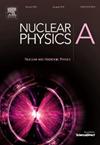有效表面近似下TOV方程和核天体物理学的细端修正
IF 2.5
4区 物理与天体物理
Q2 PHYSICS, NUCLEAR
引用次数: 0
摘要
考虑到系统表面的梯度项,采用中子星在平衡状态下的液滴宏观模型对TOV方程进行了扩展。球面情况下的史瓦西度规参数是用已知的细端近似a/R<;<;1的前导(零)阶的曲面修正得到的,其中a是NS有效表面(ES)厚度,R是有效NS半径。能量密度E的一般形式包括粒子数密度及其梯度项的函数。能量密度的宏观引力分量Φ(ρ)以最简单的形式考虑为ρ−ρ的幂形式,其中ρ是饱和密度,直到二阶,就其对分离粒子能量和不可压缩性的贡献而言。在相同的前导近似下,以简单解析形式导出了沿正法方向的NS ES上的密度分布ρ,并通过计算其NS表面修正来推导修正的TOV (MTOV)方程。采用一阶解析方法求解了MTOV方程,并将求解结果与零阶标准TOV方法进行了比较。本文章由计算机程序翻译,如有差异,请以英文原文为准。
Leptodermic corrections to the TOV equations and nuclear astrophysics within the effective surface approximation
The macroscopic model for a neutron star (NS) as a liquid drop at the equilibrium is used to extend the Tolman-Oppenheimer-Volkoff (TOV) equations taking into account the gradient terms responsible for the system surface. The parameters of the Schwarzschild metric in the spherical case are found with these surface corrections to the known leading (zero) order of the leptodermic approximation , where a is the NS effective-surface (ES) thickness, and R is the effective NS radius. The energy density is considered in a general form including the functions of the particle number density and of its gradient terms. The macroscopic gravitational component of the energy density is taken into account in the simplest form as expansion in powers of , where is the saturation density, up to second order, in terms of its contributions to the separation particle energy and incompressibility. Density distributions ρ across the NS ES in the normal direction to the ES, which are derived in the simple analytical form at the same leading approximation, was used for the derivation of the modified TOV (MTOV) equations by accounting for their NS surface corrections. The MTOV equations are analytically solved at first order and the results are compared with the standard TOV approach of the zero order.
求助全文
通过发布文献求助,成功后即可免费获取论文全文。
去求助
来源期刊

Nuclear Physics A
物理-物理:核物理
CiteScore
3.60
自引率
7.10%
发文量
113
审稿时长
61 days
期刊介绍:
Nuclear Physics A focuses on the domain of nuclear and hadronic physics and includes the following subsections: Nuclear Structure and Dynamics; Intermediate and High Energy Heavy Ion Physics; Hadronic Physics; Electromagnetic and Weak Interactions; Nuclear Astrophysics. The emphasis is on original research papers. A number of carefully selected and reviewed conference proceedings are published as an integral part of the journal.
 求助内容:
求助内容: 应助结果提醒方式:
应助结果提醒方式:


